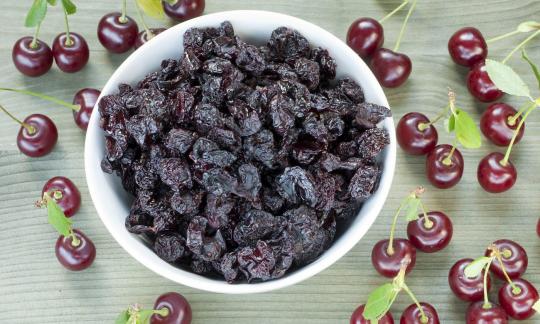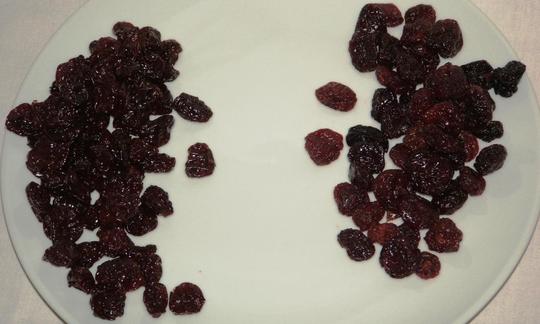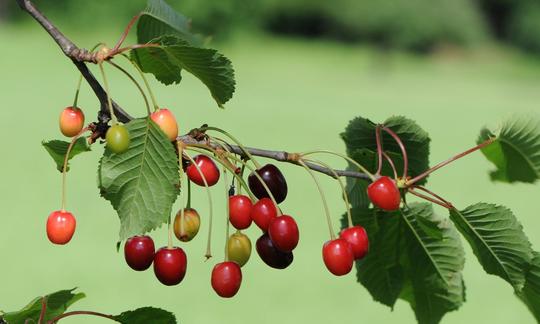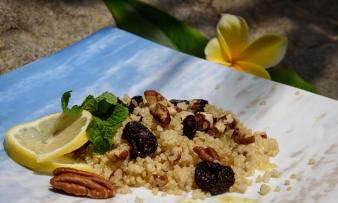Table of contents
Dried and unsweetened, sour cherries ( Prunus cerasus, also known as sour cherry) are often available raw. In contrast to the fruity sweetness of cherries or sweet cherries, sour cherries have a characteristic sour taste even when dried.
Use in the kitchen
Dried sour cherries have a fruity, sour taste. They are an enriching ingredient for sweet dishes and desserts such as cakes, muffins or other baked goods. Dried sour cherries are ideal for breakfast muesli (e.g. pea muesli), as a snack when you're a little hungry or as a topping for your favorite ice cream. The fact that fresh produce cannot be stored and is sensitive to transport puts dried sour cherries in a positive light.
Dried fruits such as dried sour cherries can also be processed into jams. To do this, soak the fruit in water for around 4 hours, chop it up with a hand blender, boil the mixture for a few minutes and fill the jam into jars. The jam made from dried fruits can be refined with bourbon vanilla, cinnamon, lemon or orange peel. For more sweetness, you can add a little sugar.
Fresh or pickled sour cherries are the most commonly used cherry variety for all kinds of baked goods, such as Black Forest cake.
Drying
sour cherries yourself is certainly possible, but pitting these small fruits is a bit more laborious than fleshy sweet cherries.
First, wash the cherries and remove the stems. A cherry pitter is usually only suitable for larger fruits, but you can definitely try it. It is important to check each cherry to make sure that there really are no stones left. If you cut the cherries by hand and remove the stones, you will probably be even faster than using a pitter. Dry the cherries with a kitchen paper towel and then place them with the cut side facing up on a baking tray or in the dehydrator.
To maintain raw food quality, cherries should not be heated above 40 °C (if the oven can be set to below 50 °C). Depending on the temperature and size of the cherries, they need to be dried in a circulating air oven for around 16 to 24 hours. To allow the moisture to escape, it is best to wedge a wooden spoon into the oven door. The dried cherries are ready as soon as they are hard, but still flexible and sticky. No more liquid should come out when you press them together.
Vegan recipe for energy balls with sour cherries
Ingredients: 60 g almonds, 15 g pistachios, 100 g dried sour cherries (pitted), 50 g pitted dates, 1⁄4 tsp vanilla extract or vanilla pulp, 2 tbsp water, sesame seeds for rolling.
Preparation: Coarsely grind the nuts in a high-performance blender, then add the cherries, dates and vanilla and mix until you have a homogeneous, sticky mass. Depending on the consistency, you can add up to 2 tablespoons of water. Form small balls and roll them in sesame seeds. Stored in cans or jars, the energy balls will keep in the fridge for up to 2 weeks.
Vegan recipes with dried sour cherries can be found under the note: " Recipes that have the most of this ingredient ".
| Not only vegans or vegetarians should read this: Vegans often eat unhealthily. Avoidable nutritional errors. |
Purchasing - Storage
Large retailers such as Coop, Migros, Denner, Volg, Spar, Aldi, Lidl, Rewe, Edeka, Billa, Hofer etc. or organic supermarkets such as Alnatura and Denns only sometimes stock dried sour cherries. In the former, they are often sweetened. Dried sour cherries are available all year round.
If possible, you should prefer organically grown cherries. Health food stores, drugstores, organic shops and online shops also sell the dried, fruity-sour sour cherries in raw food quality. A natural and gentle drying method is crucial here. When buying, look for untreated products that are free of additives and preservatives. When consuming, make sure that the product does not contain any stones or pieces of stones.
Untreated dried fruit from organic production is packaged in a protective gas atmosphere with no oxygen and high pressure. 14 They can often be recognized by their significantly darker color (especially apples or apricots). Methods involving rapid water removal, shock freezing and storage at temperatures of -34 °C as well as special pressure chambers with CO 2 can destroy pests and their eggs. Fumigation or irradiation are not used due to the EC organic regulation. 1
The availability of dried sour cherries varies depending on the size of the store, catchment area, etc. You can find our recorded food prices for the DA-CH countries above under the ingredient image - and by clicking you can see their development at various suppliers.
Storage tips
Ideal conditions for dried sour cherries are a cool, dry environment protected from light. Opened packages should therefore be used quickly or transferred to a sealable container. 39 Properly dried, dried fruit will last a very long time even without preservatives.
You should always check dried fruits for pests and mold. Dried fruits can also be frozen in small bags and thawed again as needed. 39
Ingredients - Nutritional values - Calories
The calorie content of dried sour cherries is 264 kcal/100g and the water content is less than 40%. The carbohydrate content is approximately 60%, of which 5.3% isfiber. Protein is approximately 2.7% and fat 1.5%. 2
Dried sour cherries contain 41 mg/100 g of vitamin C, which covers half of the daily requirement. Kiwis also provide a lot of the important antioxidant, with 93 mg. Better sources of the water-soluble vitamin include yellow bell peppers (184 mg/100g), black currants (181 mg/100g) or herbs such as dried wild garlic (178 mg/100g). 2 Ascorbic acid is a radical scavenger and therefore important for maintaining the human immune system. 28
Potassium is an essential element that is found in many foods. In terms of potassium content, dried sour cherries contain 798 mg/100g, which is similar to that of dried pumpkin seeds (809 mg/100g). Dried herbs contain a lot of potassium ( dried parsley : 2,683 mg/100g). Lamb's lettuce (459 mg/100g) and bananas (358 mg/100g) have a lower content. 2
The vitamin A content, as RAE, in dried sour cherries is 299 µg/100g, almost identical to that of dried wild garlic (300 µg/100g). The fat-soluble vitamin is usually present as provitamin A in the form of carotenoids in plant-based foods. Carrots, for example, have a very high vitamin A value of 835 µg per 100g of vegetables. Baby spinach is also a good source of this vitamin, with 469 µg/100g. 2
You can find all the ingredients of dried sour cherries , the coverage of the daily requirement and comparison values with other ingredients in our nutrient tables. In the article Nutrients comprehensively explained you get a detailed insight into the topic.
Health effects
What are sour cherries good for? Cherries contain flavonoids such as anthocyanins. These red, violet, blue or blue-black pigments also have bioactive properties and are antioxidant and anti-inflammatory. 3 The juice of the Montmorency sour cherry in particular is said to have positive effects due to its anti-inflammatory and antioxidant properties. 4,5
Sour cherries are said to have a positive effect against arthritis (wear and tear disease of the joints). Animal products, alcohol and coffee have a negative effect. On the other hand, a wholesome, low-fat and plant-based diet with lots of vitamins, minerals and fibre can alleviate symptoms of arthritis, gout, cardiovascular problems, digestive problems and autoimmune diseases. 29,30 Melatonin, which is also contained in sour cherries at up to 13.5 mg/g, can help with sleep disorders. If taken regularly, it can increase the natural melatonin level and, depending on the amount and variety, have a positive effect on the sleep-wake rhythm. 6,7,8
Are dried sour cherries healthy? At temperatures above 40 °C, the vitamins contained begin to be lost. Especially at high temperatures, aroma and taste can also be lost. 32 If you assume that the drying process is gentle, the resulting loss of water will concentrate the ingredients. The low water content in dried fruit means that the calorie content is significantly higher, which is why you should also use dried sour cherries sparingly. 2
Anthocyanins are water-soluble pigments in plants with the colors red, violet and blue. Their structures are very sensitive, especially when it comes to post-harvest treatment. Further processing of food can lead to a high degradation of anthocyanins. 9
The choice of drying method can also have a significant impact on the retention of vitamins and minerals. 10,24 In 2005, the Friedrich Schiller University in Jena looked into various drying processes. The so-called MVT (microwave vacuum drying) performs significantly better in terms of the content of vitamin C, anthocyanins, plant phenols and the antioxidant capacity compared to freeze- or air-dried strawberries. The loss of ingredients could be reduced by 35%. For example: 50 g of MVT-dried strawberries have the same micronutrient content as 600 g of frozen strawberries. 10
The popular "soft fruits" require additional treatment in a bath of steam after drying to maintain their soft consistency. Although they appear juicier, the nutrients suffer significantly. 1
Dried fruit is known for its high fiber content, which can promote intestinal activity. 31 When eating dried fruit, always make sure to chew slowly and salivate well, because the volume of the food determines the feeling of satiety. 40
Secondary plant substances
Many of the health effects of cherries can be attributed to the secondary plant substances they contain. Our article on secondary plant substances provides an overview of the classification of substance groups, their occurrence in foods and possible effects on humans. Cherries contain the following secondary plant substances, among others: 23
- Polyphenols : flavonoids (flavonols, flavones, anthocyanins), phenolic acids (hydroxycinnamic acids, hydroxybenzoic acids)
However, it should be noted that the composition of secondary plant substances in dried sour cherries can vary depending on the type of drying process and the temperature. 10, 24 Therefore, quantities are only of limited use and should only be understood roughly.
Dangers - Intolerances - Side effects
Various scientific institutions recommend not consuming more than about 25 g of fructose per day. If you consume more than 50 g of fructose per day, triglycerides will rise. 11 If you are fructose intolerant, you should avoid both dried sour cherries and all other dried fruits. The concentrated fructose content can cause symptoms such as a feeling of fullness, flatulence or even diarrhea with cramp-like pain. 33
Diabetics should always consume dried fruit with caution. The higher sugar content in dried fruit can cause blood sugar to rise rapidly. Dried fruit should be consumed without added sugar and in small portions. 34
Which preservatives can be found in dried fruit? To make dried fruit last longer and to preserve its color, the food industry uses sulfur dioxide (E 220) as a preservative and antioxidant. 12 The sulfur-containing compounds can also be found in the form of potassium sulfites (potassium metabisulfite: E 224, potassium hydrogen sulfite: E 228), sodium sulfites (sodium hydrogen sulfite: E 222, sodium metabisulfite: E 223) and calcium sulfites (calcium sulfite: E 226, calcium hydrogen sulfite: E 227). 18 In addition to its antibacterial effect on food, sulfur also has a bleaching effect. This is why fruits that have been treated with sulfur are lighter in color. An enzyme in the body normally ensures that this substance is broken down quickly, which is why the salts of sulfurous acid are harmless to most people in small quantities. If you have less of this enzyme, you may experience health problems such as nausea, vomiting, diarrhea and headaches. Asthmatics (sulfite asthma) or people with skin allergies can also react sensitively to this substance. 12,41 The daily sulfur content is 0.7 mg per kg of body weight. 41 According to Regulation 1333/2008/ec and the EU database for food additives, the maximum amount of sulfur dioxide in dried fruit is between 500 and 2000 mg/kg, depending on the type of fruit. 42 Sulfur-containing preservatives also reduce the absorption of vitamin B1 (thiamine) in our body. 12, 35 This water-soluble vitamin is important for the peripheral nervous system. 36
Sorbic acids are also found in conventional dried fruits (sorbic acid: E 200, potassium sorbate: E 202, calcium sorbate: E 203). 38 Although sorbic acid is naturally present in the fruits, the artificially added version can cause undesirable reactions in some people due to excessive amounts. 37
In order to preserve dried fruit, the industry also uses pesticides such as methyl bromide. This poisonous nerve gas is intended to kill pests such as mites, moths and their eggs. Although the agent is water-soluble and is supposed to evaporate quickly, residue analyses prove the opposite by detecting dangerous concentrations. This poison causes chronic health problems and damages the ozone layer more than the well-known CFCs. In addition, methyl bromide is not subject to any labeling requirements. 13
Ecological footprint - animal welfare
The ecological footprint of a food depends on various factors. The type of agricultural production (conventional vs. organic), seasonal, regional or domestic production or import by truck, ship or plane, different types of packaging and whether the goods are fresh or frozen all play a decisive role. 19
In Germany, according to Carbon Cloud, sour cherries have a CO 2 footprint of 0.75 kg CO 2 eq/kg. Freeze-dried sour cherries from Germany have 11.5 kg CO 2 eq/kg (including production, transport and processing). 20 This clearly shows how much impact food processing and transport can have.
For comparison, vegetables, one of the most climate-friendly foods, have a carbon footprint of around 0.1-0.5 kg CO 2 eq/kg depending on the cultivation method (and excluding the impact of transport). 21 The average carbon footprint of plant-based foods is around 0.66 kg CO 2 eq/kg, which represents only 10.7% of the carbon emissions of animal products (6.15 kg CO 2 eq/kg). 22 To keep your carbon footprint small, it is best to eliminate animal products from your diet.
Despite extensive research, we unfortunately do not have any concrete figures on the water footprint of dried sour cherries.
For detailed explanations of various sustainability indicators (such as ecological footprint, CO2 footprint, water footprint), see our article: What does the ecological footprint mean?
Worldwide occurrence - cultivation
Cherries probably originate from the Middle East, more precisely from Turkey. The ancient city of Kerasous (now Giresun) gave the cherries their name. The origin of the sour cherry is not entirely clear, however. 15 It is assumed that it originated from the wild cherry ( Prunus avium var. sylvestris according to Martens & Kemmler or Prunus avium) and the dwarf or steppe cherry ( Prunus fruticosa). 16
In Finland, sour cherries are cultivated up to the 63rd parallel and in Norway up to the 68th. Sour cherries sometimes grow up to altitudes of 1800 m above sea level. 16
Cultivation - Harvest
The sour cherry bush or tree can reach a height of up to 10 meters. The sour cherry grows best on loose, light, nutrient- and base-rich, sandy loam soils. After the flowering period from April to May, stone fruits form that are about 15-20 mm in size. 17 The spherical, red to dark red-black fruits are harvested from June to mid-August. The flesh can be red or uncolored depending on the variety. 17,16 ,25
For additional information on cultivation, harvesting, subspecies and differences between sweet and sour cherries, see the article Sour cherry, red, raw (soft cherry).
Industrial production
In conventional fruit growing, insecticides are unavoidable due to the pest pressure - even if Greenpeace classified the sprays used as harmful to health in 2015. 26 In particular, the larvae of the cherry fruit fly ( Rhagoletis cerasi) attack not only sour cherries ( Prunus cerasus), but also sweet cherries ( Prunus avium), honeysuckle ( Lonicera), snowberries ( Symphoricarpos) and black cherries ( Prunus padus). In organic fruit growing, attempts are made to combat these pests using close-meshed nets, sticky traps, insect-damaging nematodes and fungi. 1,27
Further information
The sour cherry ( Prunus cerasus) belongs to the rose family (Rosaceae) and the tribe of stone fruit plants (Amygdaleae). The genus Prunus also includes well-known species such as apricot ( Prunus armeniaca), plum ( Prunus domestica) and almond ( Prunus dulcis).
Alternative names
The dried sour cherry is often called dried sour cherry (plural: dried sour cherries); the sour cherry is also called tart cherry and occasionally morello.
Bibliography - 42 Sources
| 1. | Pini U. Das Bio-Food Handbuch. Ullmann: Hamburg, Potsdam. 2014. |
| 2. | USDA United States Department of Agriculture. |
| 3. | Schuster M, Hoberg E, Schütze W. Die Vielfalt der Anthocyane in Sauerkirsche, Prunus cerasus L., im Vergleich mit anderen Kirscharten, Prunus ssp. Julius Kühn-Institut. Bundesforschungsinstitut für Kulturpflanzen. 2008. |
| 4. | Schuhmacher HR, Pullman-Mooar S et al. Randomized double-blind crossover study of the efficacy of a tart cherry juice blend in treatment of osteoarthritis (OA) of the knee. Osteoarthritis and Cartilage. 2013;21(8):1035-1041. |
| 5. | Kuehl KS, Elliot DL, Sleigh AE, Smith JL. Efficacy of tart cherry juice to reduce inflammation biomarkers among women with inflammatory osteoarthritis(Oa). Journal of Food Studies. 2012;1(1):14–25. |
| 6. | Howatson G, Bell P et a. Effect of tart cherry juice (Prunus cerasus) on melatonin levels and enhanced sleep quality. European Journal of Nutrition. 2012;51:909-916. |
| 7. | Burkhardt S, Tan DX et al. Detection and quantification of the antioxidant melatonin in Montmorency and Balaton tart cherries (Prunus cerasus). Journal of Agricultural and Food Chemistry. 2001;49(10):4898-4902. |
| 8. | Losso JN, Finley JW et al. Pilot Study of the Tart Cherry Juice for the Treatment of Insomnia and Investigation of Mechanisms. Am J Ther. 2018;25(2):e194-e201. |
| 9. | Fischer M, Glomb MA. Moderne Lebensmittelchemie. Behr's Verlag: Hamburg. 2015. |
| 10. | Böhm V. Erntefrische Gesundheit haltbar gemacht. Institut für Ernährungswissenschaften der Universität Jena. Dresdner Universitätsjournal. 2005/12. |
| 11. | DAG Deutsche Adipositas-Gesellschaft e.V. Quantitative Empfehlung zur Zuckerzufuhr in Deutschland. Konsensuspapier. 2018. |
| 12. | Zusatzstoffe-online.de Schwefeldioxid. 2013. |
| 13. | Elmadfa I, Muskat E, Fritzsche D. E-Nummern. GU-Kompass E-Nummern: Alles über Lebensmittelzusatzstoffe. Gräfe und Unzer: München. 1996. |
| 14. | Jürgens H. Trockenfrüchte - Konservierungsmethoden auf dem Prüfstand. Topfruechte.de |
| 15. | Plantura.Garden. Wie kam die Kirsche nach Europa? |
| 16. | Scholz H, Scholz I. Prunus. In: HJ Conert (Hrsg.): G Hegi. Illustrierte Flora von Mitteleuropa. Spermatophyta: Angiospermae: Dicotyledones. Rosaceae. Blackwell 1995:4(2B) |
| 17. | Fleischhauer SG, Guthmann J, Spiegelberger R. Enzyklopädie - Essbare Wildpflanzen. AT Verlag: Aarau. 2013. 4. Auflage. 2018. |
| 18. | Scholz H, Scholz I. Prunus. In: HJ Conert (Hrsg.): G Hegi. Illustrierte Flora von Mitteleuropa. Spermatophyta: Angiospermae: Dicotyledones. Rosaceae. Blackwell 1995:4(2B). |
| 19. | Mekonnen MM, Hoekstra AY. The green, blue and grey water footprint of crops and derived crop products. Hydrol Earth Syst Sci. 2011;15(5):1577–1600. |
| 20. | Carbon Cloud. Cherries, Germany. 2024. |
| 21. | Pereira B de J, Cecílio Filho AB, La Scala N. Greenhouse gas emissions and carbon footprint of cucumber, tomato and lettuce production using two cropping systems. Journal of Cleaner Production. 2021;282:124517. |
| 22. | Feng S, Lakshmanan P et al. A comprehensive continental-scale analysis of carbon footprint of food production: Comparing continents around the world. Journal of Cleaner Production. 2023;426:138939. |
| 23. | Ferretti G, Bacchetti T et al. Cherry antioxidants: from farm to table. Molecules. 2010;15(10):6993–7005. |
| 24. | Nemzer B, Vargas L et al. Phytochemical and physical properties of blueberries, tart cherries, strawberries, and cranberries as affected by different drying methods. Food Chemistry. 2018;262:242–250. |
| 25. | Mein schöner Garten. Sauerkirschen. 2018. |
| 26. | Greenpeace. Europe's Pesticide Addiction: How Industrial Agriculture Damages our Environment. 2015. |
| 27. | Daniel C, Grunder J. Integrated management of European Cherry Fruit Fly rhagoletis cerasi (L.): Situation in Switzerland and Europe. Insects. 2012 Oct 16;3(4):956–988. |
| 28. | Niki E. Action of ascorbic acid as a scavenger of active and stable oxygen radicals. The American Journal of Clinical Nutrition. 1991;54(6):1119S-1124S. |
| 29. | Clinton CM, O’Brien S et al. Whole-foods, plant-based diet alleviates the symptoms of osteoarthritis. Arthritis. 2015;2015:708152. |
| 30. | Roger JDP. Heilkräfte der Nahrung. Ein Praxishandbuch. Advent-Verlag: Zürich. 2006. |
| 31. | Van der Merwe M, Moore D et al. The impact of a dried fruit and vegetable supplement and fiber rich shake on gut and health parameters in female healthcare workers: a placebo-controlled, double-blind, randomized clinical trial. Microorganisms. 2021;9(4):843. |
| 32. | nahrungsergaenzungsmittel.org |
| 33. | Fedewa A, Rao SSC. Dietary fructose intolerance, fructan intolerance and FODMAPs. Curr Gastroenterol Rep. 2014;16(1):370. |
| 34. | American Diabetes Association. Health & Wellness: Fruit. |
| 35. | Irwin SV, Fisher P et al. Sulfites inhibit the growth of four species of beneficial gut bacteria at concentrations regarded as safe for food. PLoS One. 2017;12(10):e0186629. |
| 36. | Calderón‐Ospina CA, Nava‐Mesa MO. B Vitamins in the nervous system: Current knowledge of the biochemical modes of action and synergies of thiamine, pyridoxine, and cobalamin. CNS Neurosci Ther. 2019;26(1):5–13. |
| 37. | Walker R. Toxicology of sorbic acid and sorbates. Food Additives and Contaminants. 1990;7(5):671–676. |
| 38. | Lück E. Food applications of sorbic acid and its salts. Food Additives and Contaminants. 1990;7(5):711–715. |
| 39. | Gardeningknowhow.com Drying Fruits And Vegetables: Drying Fruit For Long-Term Storage. |
| 40. | Hollis JH. The effect of mastication on food intake, satiety and body weight. Physiology & Behavior. 2018;193:242–245. |
| 41. | Chrubasik-Hausmann S. MSM (Methylsulfonylmethan). Universitäts Klinikum Freiburg. |
| 42. | European Commission. Food and Feed Information Portal Database. Sulphur dioxide - sulphites. |














Comments